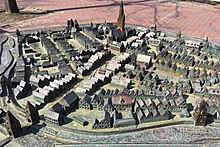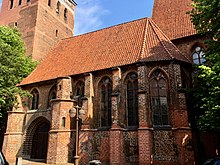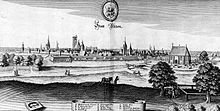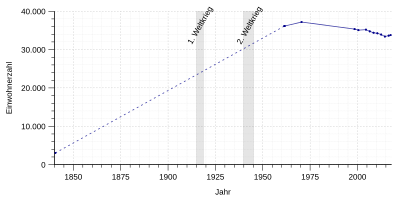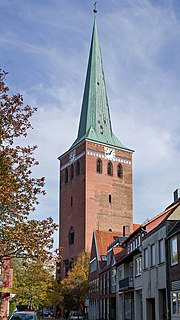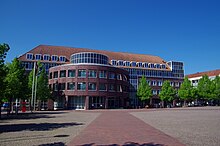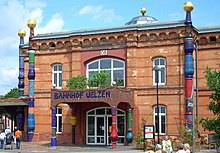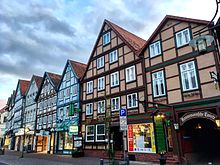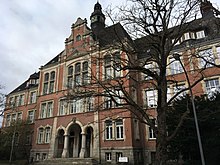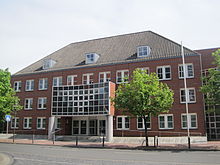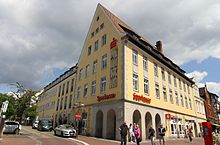Uelzen
| coat of arms | Germany map | |
|---|---|---|

|
Coordinates: 52 ° 58 ' N , 10 ° 34' E |
|
| Basic data | ||
| State : | Lower Saxony | |
| County : | Uelzen | |
| Height : | 43 m above sea level NHN | |
| Area : | 135.88 km 2 | |
| Residents: | 33,536 (Dec. 31, 2019) | |
| Population density : | 247 inhabitants per km 2 | |
| Postal code : | 29525 | |
| Area code : | 0581 | |
| License plate : | UE | |
| Community key : | 03 3 60 025 | |
| LOCODE : | DE UEL | |
| City structure: | 18 districts | |
City administration address : |
Herzogenplatz 2 29525 Uelzen |
|
| Website : | ||
| Mayor : | Jürgen Markwardt (independent) | |
| Location of the city of Uelzen in the Uelzen district | ||
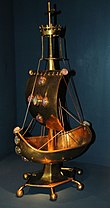
|

|
|
|
Uelz landmark: Golden ship and Hundertwasser station
|
||
The Hanse Uelzen ( Low German Ülz'n ) [ ʏltsən ] is the county town of the same district in the northeast of Lower Saxony, and part of the metropolitan area of Hamburg .
In the town charter of 1270, Uelzen initially bears the name Löwenwalde . As a member of the Hanseatic League , the city on the Ilmenau achieved a certain level of prosperity through international trade . The old town with its numerous architectural monuments is characterized by half-timbered architecture and also has some notable buildings from the north German brick Gothic.
geography
Geographical location

Uelzen lies on the edge of the Lüneburg Heath and is the center of the Uelzen basin . Due to its location on the north-south axis Hamburg-Hanover and the west-east axis Bremen-Berlin , the city is an important rail hub . The location on the Elbe Lateral Canal is also of economic importance . The city's location on the Ilmenau Heide River with green banks , small parks and meadows is attractive . In the neighborhood of large areas than were natural parks with marshes , forests , lakes and heathland designed: Elbhöhen-Wendland Nature Park , nature reserve Lueneburg Heath , South Heath Nature Park and Biosphere Reserve Lower Saxon Elbe Valley .
|
Hamburg (92 km) Lüneburg (37 km) |
Lübeck (125 km) Lauenburg (55 km) |
Schwerin (120 km) Dannenberg (41 km) |
|
Soltau (56 km) Bremen (145 km) |

|
Lüchow (43 km) Berlin (245 km) |
|
Celle (54 km) Hanover (95 km) |
Gifhorn (58 km) Braunschweig (87 km) |
Wittingen (31 km) Salzwedel (45 km) |
City structure
The Hanseatic city of Uelzen includes the districts Groß Liedern , Halligdorf , Hambrock , Hansen , Hanstedt II , Holdenstedt , Kirchweyhe , Klein Süstedt , Masendorf , Mehre , Molzen , Oldenstadt , Riestedt , Ripdorf, Tatern, Veerßen , Westerweyhe and Woltersburg .
Furthermore, there are three places in the city that have the status of “other districts”: Borne , Klein Liedern , Pieperhöfen .
climate
The mean annual temperature is 9.6 ° C, and around 660 mm of precipitation fall per year . The mean temperature is 18.6 ° C in July and 1.4 ° C in January. Between April and August, an average of 201 hours of sunshine per month can be expected. In July highs of up to 36.5 ° C and in December lows of −17.3 ° C are reached. The driest month is April, with the most rainfall in July.
History of the city
prehistory
The burial mound at the port of Uelzen dates back to the Bronze Age.
middle Ages
The roots of today's city lie in Oldenstadt ( Ulessen, Ullishusen ), a settlement in the vicinity of a monastery from the 10th century, of which the former monastery church Oldenstadt still testifies today . The Oldenstadt canonical monastery was founded around 970 by Bishop Brun I. von Verden on his estate and was consecrated to Mary and St. John the Baptist .
After disagreements with their landlord , the Bishop of Verden , some of the residents moved to the west bank of the Ilmenau around 1250 and founded their own city there. Through a feud with the Counts of Schwerin , the first regent of the Principality of Lüneburg , Guelph Duke Johann von Braunschweig and Lüneburg , was able to acquire ownership rights to the city. The newly founded city was previously under the rule of the Schwerin Count Gunzelin III. At the time, Uelzen was called Löwenwalde ( Loewenwolde, Lauenwold ) and in 1270 was given all the pertinent rights, as can be seen from an inscription on the portal of the Old Town Hall today : “On December 13, 1270, Duke Johann von Braunschweig granted Loewenwolde (Ulessen) city rights . “The name Löwenwalde appeared until the 14th century, but did not catch on because the population continued to speak of Neu-Uelzen ( Nien Ulessen ) and Alt-Uelzen ( Olden Ulessen or Oldenstadt). In the symbolism of the city coat of arms , however, the name Löwenwalde has been preserved to this day. Although around 500 inhabitants of the young town died of the plague in 1350 , Uelzen developed into a prosperous trading town . In 1371, the Saxon dukes Wenzel and Albrecht von Sachsen-Wittenberg, as ruling princes of Lüneburg, confirmed the position of Uelzen and granted the Uelzen merchants, among other things, the right to exemption from duty in the Lüneburg region in order to promote trade. The convenient location on the southern extension of the Alte Salzstrasse also had a positive effect on urban development.
In 1374 Uelzen became a member of the Hanseatic League . In the War of the Lüneburg Succession between the Guelphs and the Ascanians (1371-1388), the city was fortified with ramparts and moats as well as a city wall that had more than 20 towers and guard posts as well as three representative city gates ( Lüneburger Tor, Veerßer Tor, Gudestor ) and originally around 4, Was 5 meters high. To the west, the city was closed by the mighty Vangelturm , also known as the Black Bear . In 1396 the dukes of Celle, Heinrich der Milde and Bernhard zu Braunschweig-Lüneburg, occupied the city and started the Sate War from here in order to increase the power that had been lost by the War of the Lüneburg Succession. Only after more than a year and a half of occupation did the dukes release the city again. For this reason, the Uelzisch Poor Food has been celebrated since 1397, making it one of the oldest charitable events in the world. The Sate existed as an economic association of the three Hanseatic cities of Hanover, Lüneburg and Uelzen and the knighthood until the early 15th century. For the purpose of caring for lepers, the Uelzen provost Rupert von Nordlo founded the St. Viti Leper Hospital north of the city in 1412. The associated St. Viti chapel still exists today.
A Hanseatic day took place in Uelzen in 1470 . The town flourished well into the 16th century and was an important trading post for honey, wax, wood, cattle, furs, grain and pottery. Uelzen linen was bought from a London trading post at the Schnellenmarkt and exported to Northern Europe. In return, English cloth goods, Scottish woolen fabrics and Rhineland ceramic products came to Uelzen. Other focal points of Uelzen's long-distance trade can be identified in today's Estonia, Flanders and Norway (Bergen) .
Early modern age
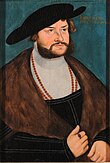
|

|
|
|
Born in Uelzer: Duke Ernst I the Confessor and Duke Franz von Braunschweig-Lüneburg
|
||

In the 16th century, Uelzen's importance as a country town within the Principality of Lüneburg increased significantly. Due to its central location, the city was the meeting place of the state parliaments six times between 1521 and 1530 . In 1506, Duke Heinrich I of Braunschweig-Lüneburg founded the state court in Uelzen, which his son, Duke Ernst I the Confessor, who was born in Uelzen, transformed into a court court in 1535 by replacing the clergy with aristocratic judges. In Fürstenhof the ducal family, the Olden townspeople Hof twenty years lived - until her death - the sister of Duke Ernst, Princess Apollonia of Brunswick-Lüneburg (1499-1571). A portrait of the princess is on her epitaph in the town church of St. Mary , where she was buried. In 1597 around 500 Uelzen residents again died of the plague.
During the Hanseatic era, the “Golden Ship”, which is today considered to be Uelzen's landmark, probably also came to the city. It is sometimes assumed that it could be a centerpiece from the 13th century that the Uelzen Hanseatic merchant Valentin von Horn , who was graced by Elizabeth I , brought back from London in 1598. With regard to its origin, its age and its former use, there are other explanatory models. The 63 centimeter high replica of a Hanseatic cog is now kept in St. Mary's Church, while a replica of the ship is in the Uelzen town hall.
As a result of existing traditions from the time of the monastery in Oldenstadt, Uelzen had already developed into an important brewing town with great economic success. Uelzen beer was also very popular in the surrounding cities, much to the displeasure of the competing breweries. In 1611, 25,000 hectoliters of beer were produced in Uelzen. In 1649 the city had 58 breweries . Under pressure from the Duke of Celle , so-called Riegebrewing was introduced in Uelzen in 1662, which resulted in strict regulation of the amount of beer. Regardless, brewers were the largest professional group in 1673, paying almost 50% of the taxes of all professions. The brewers appointed the mayor in uninterrupted succession from 1509 to 1787 .
Around five-sixths of the city, which continued to flourish until the 17th century and, after Lüneburg and Hanover, was one of the most important in the Duchy of Braunschweig-Lüneburg , was completely destroyed by a fire in 1646. Around 160 houses - including the Fürstenhof - burned down. Five of the six bells of St. Mary melted and fell into the nave. The fire disaster attracted widespread attention and sympathy. Although donations were received from all sides and Duke Friedrich IV exempted the city from all taxes for four years, Uelzen recovered only slowly. Numerous attractive half-timbered facades from this time, which were built in place of the massive, high-gabled houses, bear witness to the rapid and vigorous reconstruction .
Modern
In 1826 another city fire destroyed parts of the eastern old town, with many houses on the eastern part of Gudesstrasse, on the southern part of Lüneburger Strasse, all houses on Rademacherstrasse and Schmiedestrasse and most of the houses on Schnellenmarkt being reduced to rubble. A total of 74 houses with 130 outbuildings burned down. The reconstruction of this district was shaped by the Biedermeier house , with the gable characteristic of the early 19th century.
In 1847 the Hanover – Hamburg line through Uelzen to Harburg , at that time an independent city of the Kingdom of Hanover , was opened by the Royal Hanover State Railways . The city became a railway junction after the opening of the Bremen – Berlin line in 1873, when the so-called American line went into operation. The western section between Langwedel and Uelzen was laid out by the Bremen State Railways , the eastern section between Stendal and Uelzen was built by the Magdeburg-Halberstädter Eisenbahngesellschaft . In addition, shortly before the end of the 19th century, the railway line to Braunschweig and in 1924 the line to Dannenberg were inaugurated.
In 1871 the 4th Squadron of the 2nd Hanoverian Dragoons Regiment No. 16 moved into the new barracks on Scharnhorststrasse under the command of Rittmeister Baron von Kutzschenbach . The Uelzen Dragoons were relocated to Lüneburg in 1903 after 32 years of Uelzen garrison history.
time of the nationalsocialism
In Uelzen in 1930 around 25 percent of the electorate voted for the NSDAP , which was well above the Reich average. On April 18, 1944 and February 22, 1945, Uelzen was the target of Allied air raids as a railway junction, with parts of the city and the freight station being destroyed and dozens of casualties being mourned. In March 1945, around 500 prisoners from the Neuengamme concentration camp reached the city. To restore the tracks, the men had to do the heaviest physical labor under inhumane conditions. They were accommodated in a warehouse on the premises of the Uelzen sugar factory. The Uelzen concentration camp was established here as a satellite camp of the Neuengamme concentration camp in the last months of the war . Before the end of the war, the city officials had the prisoners brought back to Neuengamme, many of them perishing on the way.
Even in the last days of the war, the city leaders insisted not to give up Uelzen without a fight. Therefore, during the struggle for its liberation by the British Army , through fire and the use of flamethrowers, the city was further destroyed. The troops finally reached the city on April 18th. 27 percent of the built-up area was destroyed after the end of the war, including numerous half-timbered houses on Gudes, Schuh and Veerßer Strasse. Whole streets lay in ruins. Along with the Princely House, the old local history museum and all its inventory burned down on April 16, 1945. Only the gable of the provost's office remained and the St. Mariens tower was destroyed. Today's juxtaposition of Gothic buildings, modern half-timbered buildings and modern buildings is a reflection of these decisive developments. The time of National Socialism is without a doubt the darkest chapter in the city's history. Several stumbling blocks and a memorial plaque at the train station remind of the fate of victims of the Nazi regime.
post war period
There was a Uelzen-Bohldamm camp on the Bohldamm road for refugees from eastern Germany . After the end of the war until March 31, 1963, this camp became an emergency reception center for refugees from the eastern German territories, after the opening of the border from the GDR and East Berlin. Many East Berliners who left the now divided city of Berlin in the course of the construction of the Wall in 1961 were brought to the Uelzen camp. A total of over 4 million displaced persons and refugees had been registered and recorded in the cartography by the time the camp was closed in 1963.
In 1947 the Hamburg architect Konstanty Gutschow was commissioned to work out plans for the redevelopment of the city. It is thanks to him that the core city, which has been largely preserved since it was founded in 1250, has not been significantly changed. In 1985 the city council decided to renovate the inner city as part of the urban development program with the aim of preserving the historical network of streets and squares, improving the quality of living and creating an attractive point of attraction for residents and guests. Car traffic has been routed through an inner-city ring and Uelzen's “good room” is now a promenade with boutiques, cafés, restaurants and a place for cultural and traditional events. The new town hall on Herzogenplatz was built as a citizen and administrative center in 1996/1997 according to plans by the Hamburg architects Holthey, Körber and Schultz-Coulon. The Elbe Lateral Canal , which has been connecting the Elbe and the Mittelland Canal since 1976, is important for the infrastructure . Uelzen is connected to the federal waterway with a port . Locks I and II are considered technical sights .
Since April 18, 2016, Uelzen officially bears the title “ Hanseatic City ”. After Lüneburg, Stade and Buxtehude, it is the fourth city in Lower Saxony to officially use this name. In April 2015, the city had applied for the title to be awarded to the Lower Saxony Ministry of the Interior . At the New Year's reception in 2016, the city published the message that Lower Saxony's Interior Minister Boris Pistorius had granted the request.
Incorporations
On January 1, 1971, the communities Halligdorf and Hambrock were incorporated. On July 1, 1972, Groß Liedern, Hansen, Hanstedt II, Holdenstedt, Kirchweyhe, Klein Süstedt, Masendorf, Mehre, Molzen, Oldenstadt, Riestedt, Ripdorf, Tatern, Veerßen, Westerweyhe and Woltersburg were added.
Population development
The district town with around 33,500 inhabitants is the center of a surrounding area with around 93,000 inhabitants.
|
|
¹ (1961 on June 6th, 1970 on May 27th, each with the locations incorporated later; from 1998 on each December 31st)
religion
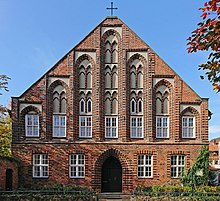
The Evangelical Lutheran Church includes the St. Marien town church , consecrated in 1292 (with the largest organ on the Lüneburg Heath), the St. Petri Church on Osterstrasse, consecrated in 1960, and the St. Johannis Church on Hagenskamp, built in 1960. For the historical churches and other chapels, see section Buildings . The old people's and nursing home Wichern-Haus on Niendorfer Straße has a prayer room.
The Catholic Church of the Divine Redeemer was built in 1904/1905 on Alewinstrasse, after which Catholic services had been taking place in the Protestant Gertrudenkapelle since 1866 . Today all Catholic churches in the Uelzen district belong to the parish of the Divine Redeemer .
The other churches and religious communities represented in Uelzen include the New Apostolic congregation founded in 1903 with the church on Alewinstraße that was inaugurated in 1962, the Evangelical Free Church Congregation ( Baptists ) founded in 1949 with the Friedenskirche on Dieterichsstraße, the independent Evangelical Lutheran Christ congregation in Uelzen the SELK with its seat at Oldenstädter Straße 26, the Evangelical-Reformed Parish Lüneburg-Uelzen with the parish hall at Oldenstädter Straße 15, the Free Evangelical Congregation (FeG) Uelzen with its community center on Lüneburger Straße, which is part of the Free Church of the Seventh-day -Adventists belonging Advent community Uelzen Am Stadtwald with the church and the neighboring retirement home on Waldstraße, the community Uelzen-Stadt founded in 2000 as the second Advent community in Uelzen with its community center on Kämpenweg, the Evangelical Free Church Community Uelze , which belongs to the Apostolic Church Germany n with the Christ Center Uelzen on the Ringstrasse, the Free Christian Community Kraftstrom Uelzen with its seat on Luisenstrasse and the Jehovah's Witnesses with the Kingdom Hall on Scharnhorststrasse.
Other churches are located in the districts of Uelzen.
politics
City council
The council of the Hanseatic City of Uelzen consists of 38 councilors. This is the specified number for a city between 30,001 and 40,000 inhabitants. The 38 council members are elected for five years each by local elections. The current term of office began on November 1, 2016 and ends on October 31, 2021.
The full-time and non-party mayor Jürgen Markwardt is also entitled to vote in the council of the Hanseatic City of Uelzen .
The council chairman is Uwe Holst (SPD). GREENS / FDP / Pirates formed a group (6 members).
Local elections on September 11, 2016
28,395 eligible voters were notified, the turnout was 50.4 percent. The parties achieved the following percentages of valid votes cast:
- SPD: 34.60 = 13 seats
- CDU: 33.16 = 13 seats
- Greens / Alliance 90: 9.42 = 4 seats
- UWG: 8.40 = 3 seats
- We for Uelzen: 6.72 = 2 seats
- The left: 2.78 = 1 seat
- FDP: 2.64 = 1 seat
- Pirates: 2.28 = 1 seat
mayor
The full-time mayor of the Hanseatic City of Uelzen has been Jürgen Markwardt, who is not a party to the party. In the last mayoral election on May 25, 2014, the previous First City Council was elected to his new office with 64.4 percent of the vote, following a proposal from the SPD. The turnout was 49.7 percent. Markwardt took office on November 1, 2014. Deputy mayors are currently Brigitte Kötke (SPD) and Markus Hannemann (CDU).
|
|
City Director
From 1945 to 1997 there were the following city directors in Uelzen as heads of administration:
- 1945–1946: Karl Sievers
- 1946–1959: Otto Helbing
- 1959–1973: Günther Goldmann
- 1973–1997: Udo Hachmann
Representative in the Bundestag
Uelzen is part of the Celle - Uelzen constituency . Henning Otte (CDU) was elected directly in 2009 and 2013 and entered the Bundestag in 2005 via the state list (19th place). Kirsten Lühmann (SPD) was also elected via the state list in 2009 and 2013. In 1998, 2002 and 2005 Peter Struck (SPD), former Minister of Defense and Chairman of the SPD parliamentary group in the German Bundestag, received the direct mandate .
coat of arms
The coat of arms of the Hanseatic city shows in the silver field a blue tinned, silver jointed city gate, on both sides two towers with three battlements each, a red pointed roof and three notches in the order of 2.1; in front of it, completely covering the doorway, a red-tongued and red-armored blue Guelph lion with a split tail between three green trees, leaning with his right paw on the right tree, in the silver shield on a green mountain .
flag
The flag shows a blue and a white half in the longitudinal direction and the city coat of arms in the middle.
Town twinning
-
 21 communes in the north and east of Rouen , with the county and communes of the county, France
21 communes in the north and east of Rouen , with the county and communes of the county, France -
 Barnstaple , UK
Barnstaple , UK -
 Tikaré , Guibaré, Burkina Faso
Tikaré , Guibaré, Burkina Faso -
 Kobryn , Belarus
Kobryn , Belarus
Culture and sights
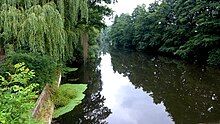
Hundertwasser station
The originally Wilhelmine Uelzen train station (built in 1888 by the architect Hubert Stier ) was converted into the Hundertwasser train station as part of the Expo 2000 world exhibition according to ideas and in the style of Friedensreich Hundertwasser . In 2009, the station received the Station of the Year award in the Small Town Stations category.
theatre
The Theater an der Ilmenau currently has 800 seats with full seating and is one of the largest guest theaters in the region. As a rule, touring theaters or music ensembles from the Herzog-Ernst-Gymnasium take place here, but numerous cabaret artists and comedians known from radio and television have also been guests in the city. In 2004 the Hundertwasser musical by Rolf Rettberg with music by Konstantin Wecker was performed here. Overall, the 71 performances were attended by over 32,500 spectators. In the gallery of the theater, the Kunstverein Uelzen e. V. offers contemporary art from November to April.
In the city center is also the one founded by Reinhard Schamuhn (1940–2013) in 1987, since 1988 by the Association for the Promotion of Art in Creative Storage e. V. operated Neue Schauspielhaus Uelzen . Cabaret is his program, and the Neue Schauspielhaus offers a wide variety of formats. In June 2006, the owner of the building, the doctor Anneliese Robby (1920–2013), gave the property to Schamuhn.
Museums
In the district of Holdenstedt is the Museum Schloss Holdenstedt , which, after being acquired by the city of Uelzen at the beginning of the 1980s, has housed the local history museum since 1985 . The permanent exhibitions include furniture from the Middle Ages to Art Nouveau , the glass collection of Uelzer honorary citizen Fritz Röver, works by the animal painter Georg Wolf (Düsseldorf School), the Pomeranian radio collection and archaeological finds from the city and country of Uelzen. Additional exhibitions, concerts and recurring events such as the art and craft market and the Holdenstedt Castle Weeks, which are known far beyond the region, are part of the castle museum's fixed program.
The Holdenstedt Castle is a former mansion of the von der Wense family that emerged from a medieval castle , the construction of which dates from the beginning of the 18th century and which now adorns a stylized baroque facade due to renovations in the middle of the 19th century . In addition to the main house, the building ensemble includes the orangery adjoining the south wing , which now houses the castle café, and in the entrance areas to the castle grounds the former modern city gates of Uelzen, a pavilion from the 19th century that was originally in a civil garden in the city of Uelzen stood, as well as an extensive English park through which the Hardau river flows behind the castle . The exhibition rooms for the archaeological department of the Uelzen local history museum are located in the watermill not far from the Holdenstedt Castle Museum . In addition, special exhibitions are shown in the watermill.
Music / meeting places
The Hanseatic City of Uelzen organizes the International Kuhlau Competition for young flutists, named after Friedrich Kuhlau , every two years (in uneven years) . The competition is aimed at flute ensembles in various compositions (two to four flutes, flute / piano and two flutes / piano); solo flutists are also permitted. The participants - the average age of an ensemble must not exceed 32 years - play works by various composers in front of an international jury, with the focus on the compositions of Friedrich Kuhlau, who was born in 1786.
Every year in summer, the "International Summer Academy Lüneburg Heath" takes place at various locations in the city and its districts under the artistic direction of the pianist Hinrich Alpers from Uelzen .
The city has a large number of music pubs and cafés, including the Komma at the Schnellenmarkt, the Hofinger , the Hutladen and Kocki's Kaminstube at the Gudestor as well as the Mephisto on Achterstraße. In the 2007 renovated Stadtgarten on the western part of the old town there is a carée with a restaurant and a café. In the city center, the “Restaurant Gildehaus”, built around 1360, borders the St. Marien Church.
Uelzen Open R.

Since 2008, the place in Uelzen Uelzen Open R - Music Festival instead. In the first year, bands like Die Ärzte , Mando Diao or Sportfreunde Stiller played in front of around 30,000 spectators. 2009 were u. a. Silbermond , Jan Delay and Amy Macdonald were guests. a. Doll & The Kicks , Eisblume , Stanfour , Ich + Ich , Culcha Candela and Die Fantastischen Vier on stage. While the festival did not take place in 2011, Herbert Grönemeyer and Die Orsons performed in 2012 .
As part of the Uelzen Open R 2016, Elton John started his European tour in front of 12,000 spectators. Moreover occurred Mark Forster , John Oerding , Glass Bead Game and Roland Kaiser on.
In August 2017, Bob Geldof , Robin Schulz , Jonas Blue , Feder, Rea Garvey , Silbermond and Max Giesinger performed . Due to a performance by Sting , the start of the festival was brought forward to August 1st. Almost 10,000 spectators came to Sting's only open-air concert in Northern Germany.
The top acts of the festival in 2018 were the Norwegian pop group a-ha and in 2019 Kim Wilde , UB40 , Paul Young and the Kelly Family .
Uelzen Film Festival
The Uelzen Film Festival is a short film festival that is held every two years and in which adolescents and young adults up to the age of 21 can participate. The main prize is the golden film role .
Sculptures

There are a number of bronze sculptures in the city area, for example in Bahnhofstrasse, on Herzogenplatz (historical city model), at the city church, in front of the tax office, at the district court and at the Ratsteich. Since 2008, numerous stone sculptures by the German-Swedish artist Dagmar Glemme have been lining the path from the Hundertwasser train station to the center and throughout the inner and old town area. At a distance of about 50 to 100 meters along the path of the stones granite blocks are set up, which the artist has painted with mythical motifs in a striking colorfulness. The stones are dedicated to certain topics. The topics addressed range from nature and dreams to happiness and freedom to love, wisdom and the elements of nature.
The Uhlenköpersage
Uelzen is also called the Uhlenköperstadt in regional usage . This comes from the legend that a citizen of Uelz bought owls (Ulen, Uhlen) instead of black cocks from a farmer :
The legend reports that a shrewd farmer from the country came to the city of Uelzen with a sack with living contents in his luggage. There he met a curious businessman who asked him what he had in the sack. The farmer replied Baarftgaans (barefoot walkers ), which the trader misunderstood as Barkhahns (black cocks ) and paid the farmer a handsome price without looking into the sack. When he got home, he wanted to show his wife the black grouse he had just bought, but when he opened the sack, three owls fluttered out and caused all kinds of damage in the merchant's apartment. The merchant then sued the farmer. However, the latter said in his defense that he had clearly sold "Baarftgaans" and that the fact that owls went barefoot cannot be denied. The judge is said to have been so amused by the farmer's cunning that he acquitted him.
That is why the people of Uelz are still called "Uhlenköper", meaning owl buyers. A bronze statue on the Marienkirche commemorates this legend. Rubbing against the statue's coin and at the same time jingling the change in your pocket should ensure that you always have enough money. The coin is therefore rubbed brightly.
Buildings
The numerous medieval churches and chapels in the city area are remarkable. Next to the oldest building, the former monastery church Oldenstadt (Romanesque stone basilica from the 12th century), here especially the Gothic St. Mary's Church (consecrated in 1292, the third highest church tower in the Lueneburg Heath), which its counterpart provost with its gothic stepped gables , the Apostelkapelle, also called Ellerndorf-Kapelle (1357), and Dreikönigs-Kapelle (1439), the St. Marien-Kirche in Veerßen and the Heiligen-Geist-Kapelle (beginning of the 14th century) Gertrudenkapelle (around 1511–13), the St. Viti Chapel (1406/1412) and the Georgskapelle Groß Liedern (after 1350) should be mentioned. The St.-Viti-chapel was part of a medieval leper colony that is detectable prior to that time Lünebürger goal since 1406th In 1866 the city hospital was established in the building.
Notable secular buildings from the Middle Ages are the old town hall (built in 1347; completely redesigned in 1789/90) and today's Ratsweinhandlung , which was built around 1500 as a dance hall behind the town hall and which is probably the oldest wine shop in Central Europe that still exists today; it still bears the medieval, Gothic stepped gable on its back. The Gothic Gildehaus building, which has been preserved from the Middle Ages, is located on Veerßer Strasse .
There are considerable half-timbered houses in Lüneburger Strasse in particular; There is also the Hotel Stadt Hamburg , built by the architect Georg Ludwig Friedrich Laves , in which the Hanover-English kings stayed on their way to the Göhrde to hunt .
High- quality buildings from the 19th century, the turn of the century and the early 20th century are the Wilhelminian post office (built after 1892) in Bahnhofstraße, today's secondary schools in Ebstorfer- and Schillerstraße, the former royal district court in Veerßer Straße or the expressionist influenced Schaumann'sche villa in Mühlenstrasse (architect Adolf Wendhut ). In 1905 the Catholic Church of the Divine Redeemer was built according to plans by Richard Herzig . The residential ensemble in Friedrich-Ebert-Straße , which is grouped around the Friedrich-Ebert-Brunnen (built in 1928), is impressive in its unity . The former Klappenbach department store is located on Gudesstrasse, and its facade , which is based on the New Building , was restored in the 1990s.
The St. Petri Church was built in 1960.
Architectural monuments
Jewish Cemetery
In the Jewish cemetery on Niendorfer Straße there are 37 tombstones for Jews from Uelzen and the surrounding area who died between 1850 and 1940. The cemetery is a protected cultural monument .
Economy and Infrastructure
economy
As the center of a growing area for agricultural products, Uelzen has an outstanding position in the food industry and the service sector . Other industries have settled around this core. The economic structure is dominated by medium-sized and small companies and supplemented by large and branch companies of corporations.
Of the 16,669 employees (as of June 2017), 8,889 work in the service sector, 3,436 in manufacturing and craft , 4,168 in trade , hospitality and transport and 176 in agriculture and forestry . The county Uelzen is from the European Union for Objective 1 region has been declared to the establishment and development of business enterprises easier. The district and city of Uelzen are part of the Hamburg metropolitan region . Within the framework of economic development, metropolitan areas and rural regions work closely together to improve infrastructure and the flow of information, promote business settlements and jointly develop markets.
- Established businesses



- Uelzen is the location of the second largest sugar factory in Europe. It is a plant of Nordzucker AG , the second largest German company in the industry, which was created in 1997 from the merger of Braunschweiger Zuckerverbund Nord AG (ZVN) and Zucker-Aktiengesellschaft Uelzen-Braunschweig (ZAG).
- As one of the largest German milk processors, the Uelzena eG dairy and food group is a major national manufacturer of dairy products such as butter , clarified butter and cheese, as well as a leading manufacturer of powdered drinks in Europe.
- Nestlé Schöller operates a plant in Uelzen with around 350 employees for the production of ice cream cups, ice cream and frozen baked goods .
- As a processor of honey , the company Dreyer known throughout Germany.
- The Bien-Holz sawmill processes around 300,000 solid cubic meters per year at the Uelzen harbor.
- The Pfeifer Group operates a sawmill with around 150 employees at the port. Sawn timber, pallet blocks and green electricity are produced here.
- C. Hasse und Sohn is a leading manufacturer of waterproofing systems for flat roofs and building waterproofing. Mastic asphalt screed work was also carried out until 2013.
- Manufacturers of office supplies, building materials and thermal systems have also set up their plants and branches in the Uelzen area.
- In addition to the manufacturing industry, service providers - for example transport companies (cobernuts, sweet milk, etc.), financial service providers and trading companies - have settled here.
- The Metronom Eisenbahngesellschaft with the brand enno has had its headquarters and its depot in Uelzen since 2003 and is one of the largest private railways in Germany with around 500 employees .
- The Expert Hanse-Verbund GmbH in Langenhagen is a consumer electronics store, and has in Uelzen a business with more than 2,000 sqm of retail space.
- The Uelzener insurance is known throughout Germany as livestock insurance and the first provider of pet health insurance for dogs, cats and horses.
- The town's long -established companies include the Ratsweinhandlung , which was built around 1500 and is therefore one of the oldest wine stores in Central Europe, the Höber shoe store (since 1670) and the L. König shipping company (since 1886), which is one of the oldest shipping companies in Germany heard.
- There is a UPS branch with a customer center and packing station in the Klein Süstedt district .
- The Stadtwerke Uelzen provide natural power in some household tariffs. They also operate the Badeland (BADUE) and public transport.
- The Holy Spirit Foundation is the oldest foundation in the city and operates a nursing home in Uelzen.
media
- The Allgemeine Zeitung der Lüneburger Heide - AZ for short - is the only daily newspaper in Uelzen with a circulation of more than 20,000 copies (first quarter of 2005). It is read by around 54,000 people. The AZ appears in the C. Beckers Buchdruckerei GmbH & Co. KG. The “Altmark Zeitung” and the “Isenhagener Kreisblatt” are also published by the publisher.
- Advertising papers in the region: Uelzener Anzeiger (publication dates: Wednesdays and Sundays) and the General Anzeiger (Sundays)
- Kick-off - unemployment newspaper for Uelzen (appears every three months)
- The non-commercial broadcaster Radio ZuSa , which is broadcast on the broadcasters Uelzen (88.0 MHz), Lüneburg (95.5 MHz) and Zernien (89.7 MHz), has its headquarters in Uelzen. The editors provide information about Uelzen, Lüneburg and the surrounding area as well as pop and rock music. The news was previously taken over by NDR 2 , since 2002 by Deutschlandradio Kultur from Berlin.
- The district media center in the extensive archive offers courses for young people and adults.
education
General education schools
In Uelzen there are two grammar schools: Lessing-Gymnasium and Herzog-Ernst-Gymnasium . Other general education schools are the Uelzen Oberschule, the primary schools at the Lucas-Backmeister-, Hermann-Löns- and Sternschule as well as the primary schools Holdenstedt, Oldenstadt, Molzen, Veerßen, Westerweyhe.
Vocational schools
In Uelzen, the vocational schools I teach the occupational fields of business and administration, metal, electrical, building, wood, color technology and interior design, personal care, nutrition and housekeeping as well as vehicle technology. In addition to the general high schools, there are the technical high schools for business and technology and the technical high schools for business and technology at BBS I. The Georgsanstalt (BBS II) also offers training courses in the areas of agriculture, horticulture / floristry, housekeeping and care, social care, care for the elderly, curative care and social education.
Public facilities
Uelzen is the location
- of the Uelzen tax office
- of the district court of Uelzen with the central dunning court of Lower Saxony
- the Federal Employment Agency
- of all major health insurance companies
- a district office of the Lower Saxony Chamber of Agriculture
- a federal police department with around 450 employees
- of the fairway and Marine Office Uelzen that of the Federal waterways Elbe-side channel and the eastern part Mittellandkanal from the lock Sülfeld near Wolfsburg to the waterway junction Magdeburg-Rothensee is responsible
- the Uelzen correctional facility
Social facilities
The HELIOS Kliniken GmbH operate in Uelzen the specialized care hospital HELIOS Klinikum Uelzen, where the rescue helicopter Christoph 19 is stationed. The HELIOS Clinic is an academic teaching hospital of the Hannover Medical School . There is also the Uelzen Psychiatric Clinic , which treats psychiatric and psychosomatic illnesses.
traffic
Rail transport
The Uelzen station is an island station and a historical traffic junction for rail traffic and belongs to station category 2. Since 2003, Uelzen has been the headquarters of the largest private railway in Germany, the Metronom Eisenbahngesellschaft , which also operates train services under the enno brand . The station is served by trains of Deutsche Bahn AG , erixx GmbH and the Metronom Eisenbahngesellschaft and is the stop of the intercity lines 26.1 from Karlsruhe to Hamburg (- Rostock - Binz ) and 26.2 from Hamburg via Würzburg to Augsburg (- Munich (- Berchtesgaden )) as well as on the edge of the day of the ICE from / to Frankfurt am Main , Munich and Hamburg . The Interregio-Express train pair Berlin – Stendal – Uelzen – Hamburg also stop here once a day .
There are also regional connections via Soltau to Bremen ( Uelzen – Langwedel line ), via Gifhorn to Braunschweig ( Wieren – Braunschweig line ) and to Magdeburg via Stendal ( Stendal – Uelzen line ). Operation on the last-mentioned route became possible again after the interrupted section from Salzwedel to Nienbergen was rebuilt in connection with the transport projects. This route is also used by trains between Hamburg and Berlin when the high-speed route is not available. From Uelzen, the Uelzen – Lüneburg – Hamburg and Uelzen – Hanover – Göttingen routes are operated every hour with the metronom . The conversion to the Hundertwasser station on the occasion of the Expo 2000 made the railway junction internationally known.
In addition to the Inselbahnhof, the "Hannöversche Bahnhof", built in the English Tudor style, existed since 1853 and was demolished in 1933. Two previous buildings in turn - a half-timbered station and the so-called "Halberstädter Bahnhof" - were demolished and rebuilt in Luisenstrasse and Ringstrasse.
Road traffic
Uelzen is located in the middle of one of the largest areas in Germany that is not accessible by highways. The A 39 has been planned for many years; however, it is not expected to be implemented before 2020. In the Uelzen region there are both supporters and critics of motorway construction.
From Uelzen the federal highway 4 leads via Gifhorn and Braunschweig to Bad Harzburg and further south over the Harz to Nordhausen . In the opposite direction, the Bundesstraße 4 leads north to Hamburg via Bad Bevensen and Lüneburg. At the end of 2003 a spacious bypass road was completed, which branches off the old route south of Holdenstedt, runs between the city and the Oldenstadt district along the Elbe side canal and meets the old route again in the north of the city. Due to the high truck load (abbreviation between the economic areas of Hamburg and Braunschweig-Wolfsburg-Magdeburg), the introduction of mandatory tolls was briefly discussed. Since the summer of 2006, the B4 has been closed to transit traffic over 12 tons.
The federal highway 191 leads to the southwest via Eschede to Celle . To the northeast it leads across the north of the Hanoverian Wendland to Dannenberg , crosses the Elbe on the Dömitzer Elbbrücke and continues via Ludwigslust and Parchim to Plau am See . The federal highway 493 leads to the east via Lüchow (Wendland) to Schnackenburg (Elbe). The federal road 71 leads to the west via Munster to Soltau. At the Soltau-Ost junction, the B71 crosses the A7 federal motorway. In the opposite direction, the B71 leads to Salzwedel and on via Gardelegen and Haldensleben to Magdeburg .
Shipping
Through the port on the Elbe Lateral Canal , Uelzen is connected to the European inland waterway network and connected to the seaports of the Hanseatic cities of Hamburg and Lübeck as well as to the industrial and commercial centers of Hanover , Braunschweig , Salzgitter and Magdeburg . The port can be called by ships of inland shipping class Vb ( European ships ) and push convoys up to 200 m in length and, like the adjacent industrial area, has a siding. Due to the steadily increasing handling figures (most recently 430,000 tons per year) there are considerations to designate a new industrial and commercial area of up to 100 hectares on the east bank of the Elbe Lateral Canal and to build another quay . The Uelzen II lock , located southeast of the city near Esterholz , was built by 2006 for 122 million euros and, with a lifting height of 23 meters and a chamber length of 190 meters - after the new locks of the Panama Canal - is the largest economy lock in the world. It can be used by commercial shipping in 24-hour operation. The parallel lock Uelzen I with a chamber length of 185 meters is still in operation due to the high volume of traffic at times. In Uelzen-Groß Liedern there is a sports boat harbor with over 40 berths.
air traffic
In the western village of Barnsen, Uelzen owns an airfield with an asphalt runway 800 meters long and 20 meters wide. The airfield can be approached by airplanes and helicopters with a gross vehicle weight of 5.7 tons. In addition to private sport aviation, the space is also used by business pilots. The nearest commercial airports are Hanover Airport (around 80 km) and Hamburg Airport (around 90 km).
Public transport
The Stadtwerke Uelzen operate an existing four lines in the urban area city bus service . A possible integration into the Hamburger Verkehrsverbund has been considered several times, but this has not yet been implemented due to the high costs. In addition to initial costs of over one million euros, an annual 500,000 to 700,000 euros would have to be raised (as of 2007/08). Plans to connect Uelzen to the Braunschweig regional light rail network were discontinued in 2010.
Personalities
sons and daughters of the town


- Mola Adebisi (* 1973), former TV presenter (VIVA)
- Hinrich Alpers (* 1981), pianist
- Karl Friedrich Benkowitz (1764–1807), playwright and poet
- Sören Bertram (* 1991), soccer player (FC Augsburg, Hamburger SV)
- Conrad Gottfried Blanckenberg (1657–1712), Lutheran theologian, provost in Berlin
- Ludwig Heinrich Bernhard Bornemann (1817–1896), lawyer and honorary citizen of Harburg
- Ernst Cregel (1628–1674), lawyer, professor in Altdorf
- Duke Ernst of Braunschweig-Lüneburg (1497–1546), Prince of Lüneburg
- Duke Franz of Braunschweig-Lüneburg-Gifhorn (1508–1549)
- Nanna Conti (1881–1951), midwife, NSDAP member, 1933–1945 head of the “Reichsfachschaft Deutscher Midwife”, mother of the “Reichsärzteführer” Leonardo Conti (1900–1945)
- Carl Otto Dammers (1811–1860), lawyer and politician
- Friedrich Wilhelm Diterichs (1702–1782), architect, engineer and construction clerk in Prussia, among other things he created the Prinzessinnenpalais and the Ephraim-Palais in Berlin as well as the orangery and the terraces in the garden of Sanssouci in Potsdam
- Armin Dittmann (* 1945), lawyer and professor at the Universities of Hamburg and Hohenheim
- André Doehring (* 1973), musicologist and professor at the Art University Graz
- Theodor Ernst (1904–1983), mineralogist and professor at the University of Erlangen
- Friedrich Gerke (1900–1966), art historian
- Charlotte Greve (* 1988), jazz musician
- Jens Häusler (* 1967), handball player and coach
- Rebecca Harms (* 1956 in Hambrock), politician ( Greens )
- Hermann Hölty (1828–1897), poet
- Gerhard Kadow (1909–1981), art professor at the former Cologne factory schools
- Theodore Kaufmann (1814–1896) ( Theodor Kaufmann ), American painter of German descent
- Christian Keltermann (* 1977), cabaret artist, comedian and book author
- Friedrich Klinge (1883–1949), politician ( DP ), Lord Mayor of Goslar and Member of the Bundestag (DP parliamentary group leader)
- Ludwig König (1944–2016), entrepreneur in Uelzen, initiator of the new edition of Uelzischer Armenessen , former monitor of the Gertrudenstiftung .
- Friedrich Krollpfeiffer (1892–1957), chemist
- Ulf Krüger (* 1947), musician, lyricist, composer, producer, author and manager
- Friedrich Kuhlau (1786–1832), court composer at the Danish royal court
- Caspar Lehman von Lewenwaldt (around 1563–1622), “court cammer stone grinder” under Emperor Rudolf II, inventor of modern glass cutting
- Erich Münter (1871–1915), German-American university professor and assassin on JP Morgan jr.
- Johann Niebur († 1399), Lübeck mayor
- Stefan Porwol (* 1955), lawyer and politician (CDU)
- Lionel Pracht (1875-1945), German civil servant and politician (DDP)
- Fritz Röver (1912–2004), honorary citizen of the city of Uelzen. Graduate engineer, councilor and senator for culture of the city of Uelzen, chairman of the museum and local history association, founder of the Röver glass collection.
- Johann Christoph Salfeld (1750–1829), Protestant theologian, consistorial director and abbot in Loccum monastery
- Thomas Scharff (* 1963), historian
- Margarete ("Grete") Schlemm (1893–1963), heath poet
- Karlgeorg Schuster (1886–1973), naval officer, most recently admiral in World War II
- Heinrich Schwieger-Uelzen (1902–1976), graphic artist and painter
- Karl Söhle (1861–1947), initially a teacher in Lower Saxony, later a music critic and writer in Dresden. Since 1917 music professor hc
- Ludwig Teichmann (1909–1947), SS-Sturmbannführer, executed as a war criminal in Belgrade
- Christoph Martin Vogtherr (* 1965), art historian , director of the Hamburger Kunsthalle
- Angelika Volquartz (* 1946), politician (CDU), 2003–2009 Lord Mayor of Kiel
- Ernst Wackenroder (1876–1959), art historian and monument conservator
- Walter Wallmann (1932–2013), politician (CDU), including Federal Minister for the Environment, Nature Conservation and Nuclear Safety and Prime Minister of the State of Hesse
- Johannes Wedde (1843–1890) poet, social democrat and journalist
- André Wieckenberg (* 1979), radio and television presenter (MDR)
- Georg Wilding, Prince of Butera Radali (1790–1841), royal Neapolitan envoy to St. Petersburg
- Daniel Wilhelmi (1623–1689), Protestant theologian
- Harald Zahrte (* 1957), politician (independent) and administrative officer
- Eberhard August Wilhelm von Zimmermann (1743–1815), geographer and biologist
- Theodor Zincke (1843–1928), chemist
Other personalities associated with the city
- Thorben Albrecht (* 1970), permanent state secretary in the Federal Ministry of Labor and Social Affairs ; did his Abitur at the HEG.
- Lucas Bacmeister (1672–1748), provost and superintendent of Uelzen, namesake of the local Lucas Bacmeister school
- Werner Bergengruen (1892–1964), Baltic German writer. Uelzen has been the seat of the Werner Bergengruen Society since 2007, which has been awarding the Werner Bergengruen Prize in Uelzen since 2009
- Duchess Apollonia von Braunschweig-Lüneburg (1499–1571), sister of Duke Ernst the Confessor, resided in the Princely House of Uelzen after the conversion to the Evangelical Lutheran faith
- Wilhelm Ditzen (1852–1937), district judge in Uelzen from 1886 to 1890, father of the writer Hans Fallada
- Hans-Alexander Drechsler (1923–2002), 1979 to 1981 mayor of Uelzen
- Johann Peter Eckermann (1792–1854), clerk and tax assistant in Uelzen, later a trusted colleague of Johann Wolfgang von Goethe
- Christian Freiherr von Hammerstein (1769–1850), an important modernizer of agriculture, died in Uelzen in 1850
- Christian Hoburg (1607–1675), an important Protestant controversial theologian and mystical spiritualist, was from 1635 to 1640 subconrector and preacher in Uelzen
- Dietrich H. Hoppenstedt (* 1940), 1977 to 1979 senior district director in Uelzen and from October 1, 1998 to April 30, 2006 President of the German Savings Banks and Giro Association
- Christa Meves (* 1925), Christian therapist, author, co-editor of Rheinischer Merkur
- Raimund Nowak (* 1955), state chairman of Bündnis90 / Die Grünen, worked as a local politician in the district from 1986–2001 and chairman of the Green parliamentary group in the city council
- Ruth Schaumann (1899–1975), sculptor and poet, spent parts of her childhood with her grandparents in the mill on the Ilmenau.
- Peter Struck (1943–2012), until November 22, 2005 Federal Minister of Defense under the Gerhard Schröder government , then Chairman of the SPD parliamentary group; lived in Uelzen (November 2008)
- George Turner (* 1935), University President Hohenheim, President of the West German Rectors' Conference and Berlin Senator for Science, graduated from high school in 1955 at the HEG
- Georg Wolf (1882–1962), landscape and animal painter from the Düsseldorf School . Training at the Strasbourg School of Applied Arts and the Düsseldorf Academy; has lived in Uelzen since 1944, married there to the heath poet Grete Schlemm since 1960. Works that are still traded internationally at auctions today. A permanent exhibition is located in the Museum Schloss Holdenstedt near Uelzen
- Rainer Zobel (* 1948), soccer player (including FC Bayern Munich), multiple German soccer champion and today's coach, played for SC 09 Uelzen at the beginning of his career
- Sebastian Selke (born February 22, 1974 in Hilden) is a former German soccer player who is now a goalkeeping coach in Liechtenstein for FC Vaduz. Selke lived in Uelzen at the beginning of his career and played at SC 09 Uelzen and Lüneburger SK, among others.
literature
- Dietrich Banse, Ed .: humiliated, expelled, murdered - Uelzen citizens of Jewish faith between 1933 and 1945 . Commissioned by the history workshop Uelzen, Uelzen 2008. Book accompanying the exhibition of the same name on November 9, 2006 in the foyer of the Uelzen town hall. The book can be purchased from the history workshop in Uelzen.
- Jens Büttler (Ed.): The way of the stones. Dagmar Glemmes stone sculptures in Uelzen. Jens Büttler Verlag, Uelzen 2008, ISBN 978-3-9808955-5-2 .
- Ralf Busch : Uelzen. In: Herbert Obenaus (Ed. In collaboration with David Bankier and Daniel Fraenkel): Historical manual of the Jewish communities in Lower Saxony and Bremen. 2 volumes. Göttingen 2005, ISBN 3-89244-753-5 , pp. 1486-1491.
- Reimer Egge: Dealing with German Unity and Democracy: Uelzen since reunification 1990 to 2010. City of Uelzen, Uelzen 2011, ISBN 978-3-9809676-9-3 .
- Reimer Egge: Communist movement and activities in the Uelzen region since the 1920s until the dissolution of the GDR. Uelzen in the 20s to 1989. City of Uelzen, Uelzen 2011, ISBN 978-3-9809676-7-9 .
- Reimer Egge: From Stresemann to Braunhemd - Uelzen from 1918 to 1945 . On behalf of the city of Uelzen. Becker Verlag, Uelzen 1985. (Reprint on behalf of the city of Uelzen, K + R Druck, Uelzen 2004)
- Stephan Heinemann : Jewish life in the small towns of Walsrode and Uelzen in northeast Lower Saxony . Walsrode 2001, ISBN 3-9803242-6-5 .
- Horst Hoffmann: Uelzen. Face of a city. With photos by Peter Siegmund and texts by Horst Hoffmann. Becker, Uelzen 1989, ISBN 3-920079-26-4 .
- Horst Hoffmann: Uelzener ABC. (= Writings on Uelzen local history. Issue 15). Becker, Uelzen 2001, ISBN 3-920079-44-2 .
- Lothar Kasper, Heinrich Priesterjahn, Klaus-Dieter Tröger: Uelzen and the railway. Bahn Media Verlag, Suhlendorf 2009, ISBN 978-3-940189-08-0 .
- City of Uelzen (Ed.): Uelzen in the picture. City of Uelzen, Uelzen 2000.
- Ernst Straßer: The St. Marienkirche in Uelzen. Becker, Uelzen 1958.
- Hans-Jürgen Vogtherr: Uelzen in the Hanseatic League. (= Contributions to Uelzen regional history. No. 1). Horst Hoffmann, Uelzen 2016, ISBN 978-3-9815331-7-0 .
- Thomas Vogtherr: Uelzen. History of a city in the Middle Ages. with a contribution by Hans-Jürgen Vogtherr. Becker, Uelzen 1997, ISBN 3-920079-42-6 .
- Thomas Vogtherr (ed.): Document book of the city of Uelzen. (= Lüneburg document book. 14th section). August Lax, Hildesheim 1988 [] ISBN 3-7848-3018-8 .
- Hans von der Ohe: brewers, beer and citizens. A contribution to the history of the city of Uelzen. Becker, Uelzen 1972.
- Angelika Weber: Uelzen Bibliography. The literature about the city and the district from the beginning up to the year 2000. Published by the Museum and Heimatverein des Kreis Uelzen e. V. on the occasion of its 75th anniversary in 2004. Museum and Heimatverein des Kreis Uelzen e. V., Uelzen 2004, ISBN 3-929864-04-7 .
- Eckehard Niemann: National Socialism in the Uelzen district. Volume 1: 1925-1933. Volume 2: 1933-1939. Volume 3: 1939-1945. Self-published by E. Niemann, Varendorf, 2014, 2016 and 2017.
Web links
- Official website of the city of Uelzen
- Website on the city history of Uelzen
- Link to the history workshop Uelzen
- Historical tour through Uelzen
Individual evidence
- ↑ State Office for Statistics Lower Saxony, LSN-Online regional database, Table 12411: Update of the population, as of December 31, 2019 ( help ).
- ^ Eduard Kück: Lüneburg Dictionary. Vocabulary of the Lüneburg Heath and its peripheral areas, collected together with many employees since 1900 and explained linguistically and ethnologically by Professor Dr. Eduard Kück. Third volume: S – Z. Karl Wachholtz, Neumünster 1967.
- ↑ Caspar Ehlers : The integration of Saxony into the Frankish empire. Göttingen, 2007, p. 88; Nathalie Kruppa: The Billungers and their monasteries. Examples of the extensive connections in early medieval Saxony. In: Concilium medii aevi. Volume 12, 2009, pp. 1–41, here p. 22.
- ↑ Thomas Vogtherr: Uelzen. History of a city in the Middle Ages. Becker, Uelzen 1997, ISBN 3-920079-42-6 .
- ↑ Horst Hoffmann: Uelzen. Face of a city. With photos by Peter Siegmund and texts by Horst Hoffmann. Becker, Uelzen 1989, ISBN 3-920079-26-4 .
- ↑ Horst Hoffmann: Uelzen. Face of a city. With photos by Peter Siegmund and texts by Horst Hoffmann. Becker, Uelzen 1989, ISBN 3-920079-26-4 .
- ↑ Thomas Vogtherr: Uelzen. History of a city in the Middle Ages. Becker, Uelzen 1997, ISBN 3-920079-42-6 .
- ↑ a b In the footsteps of the Hanseatic League in Uelzen, AZ-Online, April 16, 2016
- ↑ Thomas Vogtherr: Uelzen. History of a city in the Middle Ages. Becker, Uelzen 1997, ISBN 3-920079-42-6 .
- ↑ Bettina Pauline Bombeck: Squares and square design from a traffic-cultural point of view - An analysis of downtown Uelzen with special consideration of pedestrian issues. Diplomica Verlag, Hamburg 2012, p. 21 f.
- ^ Matthias Blazek: Uelzen and the Railway - The Harburg – Celle railway was put into operation in 1847. In: The Heidewanderer. Local supplement of the Allgemeine Zeitung. Uelzen, 87th year, No. 30, 2011, pp. 117 ff.
- ↑ Horst Hoffmann: Uelzen. Face of a city. With photos by Peter Siegmund and texts by Horst Hoffmann. Becker, Uelzen 1989, ISBN 3-920079-26-4 .
- ↑ Uelzen is officially a Hanseatic city. In: AZ-Online, January 9, 2016.
- ↑ a b Federal Statistical Office (ed.): Historical municipality register for the Federal Republic of Germany. Name, border and key number changes in municipalities, counties and administrative districts from May 27, 1970 to December 31, 1982 . W. Kohlhammer, Stuttgart / Mainz 1983, ISBN 3-17-003263-1 , p. 236 .
- ^ Lower Saxony Municipal Constitutional Law (NKomVG) in the version of December 17, 2010; Section 46 - Number of MPs , accessed on December 1, 2014.
- ↑ Detailed results of the city council election in Uelzen ( Memento from January 6, 2017 in the Internet Archive ), accessed on January 6, 2016.
- ↑ hansestadt-uelzen.de
- ↑ Individual results of the direct elections on May 25, 2014 in Lower Saxony , accessed on December 1, 2014.
- ↑ Werner H. König: Lower Saxony between Aller and Elbe . Missionshandlung Herrmansburg 1987, ISBN 3-87546-047-2 .
- ↑ a b General Statute of the City of Uelzen ( Memento of January 13, 2017 in the Internet Archive ), accessed on December 1, 2014.
- ↑ Erfurt and Uelzen are train stations of the year. www.welt.de, accessed on February 22, 2011 .
- ↑ Exhibition locations of the Uelzen Art Association
- ^ History and collections of the Museum Schloss Holdenstedt on the official website of the museum (accessed December 17, 2011).
- ^ History of Schloss Holdenstedt on the museum's official website (accessed December 17, 2011) .
- ^ Report on Elton John's appearance at the Uelzener Open R ( memento from June 4, 2016 in the Internet Archive ) of the NDR
- ^ Report of the NDR about the appearance of Sting. August 2, 2017 ( Memento of August 3, 2017 in the Internet Archive )
- ↑ A-ha, Michael Patrick Kelly and Tom Gregory - the brilliant Open-R prelude. Allgemeine-Zeitung Uelzen, August 12, 2018, accessed on January 28, 2020 .
- ↑ Program Open R Festival 2019 ( Memento from June 10, 2019 in the Internet Archive )
- ↑ Report on the awarding of prizes at the Uelzener Filmtage ( memento from April 12, 2013 in the web archive archive.today ) by NDR
- ↑ See data from the Society for Leprosy under Medieval Leprosories in Bremen and Lower Saxony ( Memento from July 4, 2015 in the Internet Archive )
- ↑ Figures, data, facts of the Hanseatic City of Uelzen. www.hansestadt-uelzen.de, accessed on September 21, 2018 .
- ↑ How does it work? From beet to sugar. www.ndr.de, accessed on March 16, 2017 .
- ↑ 20 million for the Uelzen harbor. AZ-Online, April 8, 2016.
- ↑ Bow to the hundredth . In: az-online.de . March 12, 2012. ( az-online.de ( Memento from November 11, 2017 in the Internet Archive ))



